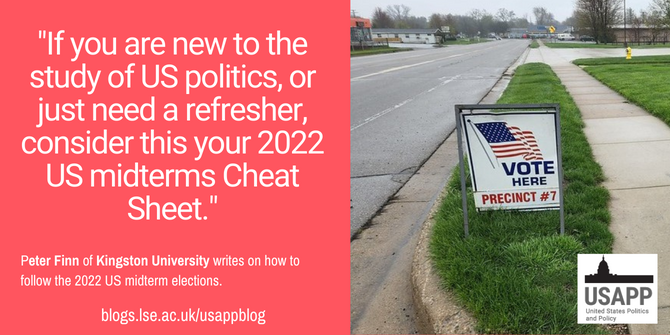 Even for those who regularly study and write about US elections, they can appear complex and hard to follow. Ahead of the 2022 midterms, which will see elections for 435 US House members, 34 US Senators and hundreds of state and local officials, Peter Finn highlights some useful numbers that can act as shortcuts to navigate the next few months, and provide background for the midterm results as they come in.
Even for those who regularly study and write about US elections, they can appear complex and hard to follow. Ahead of the 2022 midterms, which will see elections for 435 US House members, 34 US Senators and hundreds of state and local officials, Peter Finn highlights some useful numbers that can act as shortcuts to navigate the next few months, and provide background for the midterm results as they come in.
- Looking ahead to elections across the US in 2022, our mini-series, ‘The 2022 midterms‘, explores aspects of elections at the presidential, Senate, House of Representative and state levels, and also reflects on what the results will mean for US politics moving forward. If you are interested in contributing, please contact Rob Ledger (ledger@em.uni-frankfurt.de) or Peter Finn (finn@kingston.ac.uk).
As I noted in a previous post, the US electoral system has many levels, changes across time, and is hard to follow, even for a seasoned observer. There are, however, some relative constants that do offer some stability to those looking to understand and interpret US politics. If you are new to the study of US politics, or just need a refresher, consider this your 2022 US midterms Cheat Sheet.
Four Year Cycles
US elections generally slot into a four-year cycle, with most taking place either alongside a presidential election (often referred to as a ‘general election’) or as part of the midterms that occur every two years at the halfway point between presidential elections. The elections in November 2022 are midterms. Some elections occur in the years between presidential and midterms, and these are referred to as off year elections.
Presidential and midterm elections run in early November. There was some discussion early in the COVID-19 pandemic of changing the date of the 2020 President Election. However this was quickly ended as the 20th Amendment to the US Constitution mandates that the ‘terms of the President and the Vice President shall end at noon on the 20th day of January’ following an election. This obviously leaves little logistical wriggle room.
Given the size of the US, unscheduled elections are common when events such as resignations, recalls, or office holders passing away occur. These special elections can run at different points in a cycle but at the same time as other elections (i.e., in a midterm rather than a presidential election) or on other dates.
50 States (plus Washington DC and Overseas Territories)
Rather neatly, the US has 50 states. This number has not been fixed since the founding of the US. Indeed, the US has grown from just 13 states at the time the Constitution was written in 1787 to the 50 reached when Alaska and Hawaii gained statehood in 1959. As I explored with Madison Imiola in a previous piece, the current state and national geography of the US, and thus what elections run and where, was not preordained, but instead reflects the US’s complex, often troubling, history. Had, for instance, events such as the Louisiana Purchase occurred differently, or not transpired at all, the contemporary US state and electoral map may look very different.
Complicating the neatness of 50 states is the fact that Washington DC and five overseas territories (American Samoa, Guam, Puerto Rico, Northern Mariana Islands, and the U.S. Virgin Islands) do not have statehood. Overseas territories do not have federal elected representatives, nor can those who live in them vote in presidential elections. Washington DC, meanwhile, does not have federal elected representatives but has had three electoral college votes since 1961. In short, the more than 4 million people who live in Washington DC and overseas territories will not be voting in federal elections this November. This situation feeds into long running campaigns for statehood.
100 Senators, 435 House Members
Each US state is allotted two senators, who, in an outlier to the four-year cycle, are elected to six-year terms. Bar special elections, US senate elections are split evenly across three November elections (33, 33, 34). Key Senate elections in 2022 include Georgia, Nevada, and Pennsylvania.
The US House of Representatives has 435 members, which are apportioned by state population. All House seats are up for election every two years. Every ten years seats are reapportioned using population information from the Census, with states that grow in population relative to others gaining seats and those that shrink relative to others (though not necessarily in absolute population numbers) losing seats. This process feeds into districts being redrawn within states. Redistricting can be controversial, with courts often deciding on whether maps are valid in complex long running cases.

“Election Day (Ypsilanti Township, Michig” (CC BY-NC-SA 2.0) by cseeman
Two Parties
For better or worse US politics has, since the 1860s, been dominated by the Republican Party and the Democratic Party. At present the Republican Party is dominant in large parts of the south and Midwest, whilst the Democrats dominate the East and West coasts, large cities, and parts of Sun Belt states.
The policies and identities of the parties can shift significantly over time. However, at present the Democratic Party is associated more with liberal leaning and left wing ideas, while the Republican Party is generally aligned with right wing thinking and a distrust of government (though rather strangely it appears it is not possible to find a single document or page laying out national Republican Party positions, with a page on their website encouraging people to ‘[l]earn More About Our Platform and Where We Stand’ actually linking to a document on party rules). However, as they are just two parties representing one of the world’s largest democracies, these identities are not necessarily coherently represented, and it is often better to think about them as coalitions that shift over time rather than entities that stick to a fixed set of ideals or policies across time.
There are other US political parties, with notable examples being the Libertarian Party and the Green Party. Moreover, former candidate for the Democratic nomination for president Andrew Yang and former Republican Governor of New Jersey Christine Todd Whitman have recently been involved in the launch of the Forward Party, which is attempting to locate itself squarely in the centre ground of US politics. However, at present US politics looks set to continue to be dominated by the Republican Party and the Democratic Party for the foreseeable future.
- Please read our comments policy before commenting.
- Note: This article gives the views of the author, and not the position of USAPP – American Politics and Policy, nor the London School of Economics.
- Shortened URL for this post: https://bit.ly/3LXieP7






